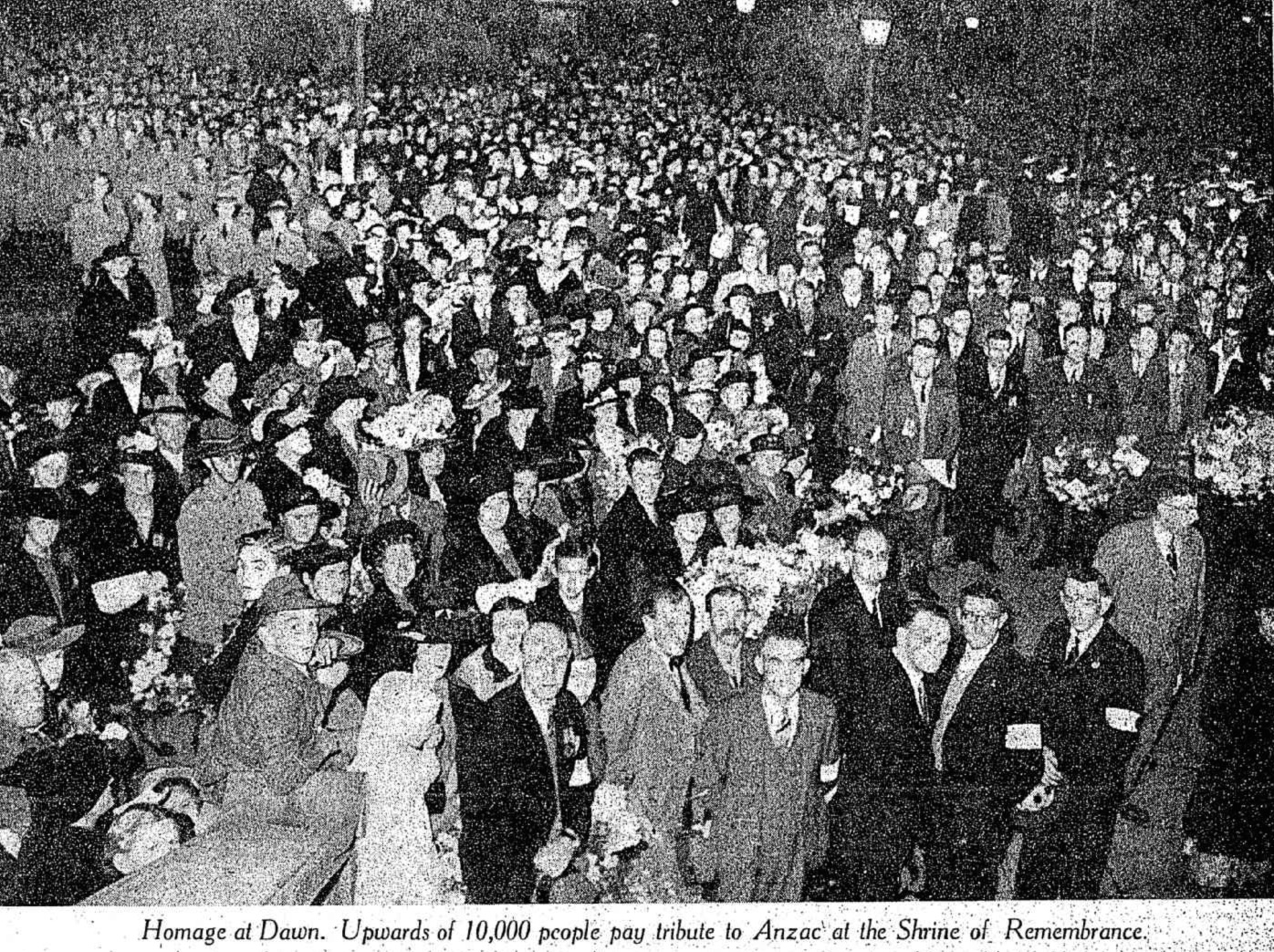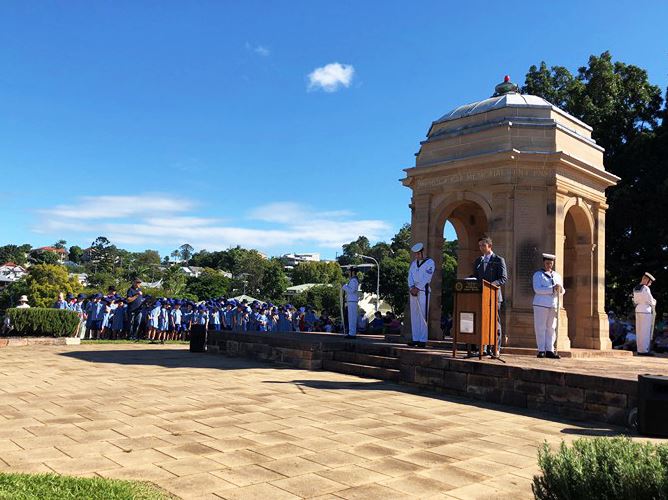ANZAC Square tablet
TRIBUTE TO
SERVICE.
National Memorial.
UNVEILING
OF TABLET.
ANZAC Square which has been the scene of much industry in recent weeks became the scene of more solemnity on Saturday [ 24 May 1930 ] when the Governor (Sir John Goodwin) [ Sir Thomas Herbert John Chapman Goodwin ] unveiled the inscription tablet on the National War Memorial monument which is rapidly taking definite form.
It was the first public function in connection with the memorial square and was a preliminary to the unveiling of the memorial itself.
It was an impressive and dignified ceremony and in spite of the fact that the time and the day could not have been convenient to business people, there was a big gathering present.
Many returned soldiers attended, and the presence of several men in uniform gave an air of militarism to the proceedings. The square was gay with bunting which was hung in long lines from the Adelaide Street entrance back to the memorial on the Ann Street frontage. Work on the monument was temporarily suspended.
The Governor was accompanied by Lady Goodwin and was attended by Lieutenant Colonel L.E.C. Worthington-Wilmer [ Louis Emilius Chelmer Worthington-Wilmer ]. The Lord Mayor (Alderman W.A. Jolly, C.M.G.) [ William Alfred Jolly ] received the Vice-Regal party and escorted them up the steps to the base of the memorial.
REPRESENTATIVE GATHERING.
The representative gathering on the temporary platform included the Treasurer (Mr. W.H. Barnes) [ Walter Henry Barnes, State Member for Wynnum, also Bulimba ], representing the Government, Brigadier E.M. Ralph (Officer Commanding the Field Troops in Queensland) [ Edgar Maurice Ralph, D.S.O. ], Lieutenant-Commander J.C. McFarlane (District Naval Officer) [ John Clement McFarlane ], Canon Garland [ David John Garland ] (secretary of the Queensland National Anzac Memorial Committee), and members of the committee, and Mr. H. Fraser East (president of the Queensland branch of The Returned Sailors’ and Soldiers’ Imperial League of Australia) [ Hubert Fraser East ].
The memorial tablet, which is set in the stone face of the monument looking towards Adelaide Street, was covered with a large Union Jack, and surmounting the monument were two flagpoles on which wore the Union Jack and the Australian flag, furled. A sailor and a soldier wearing uniforms stood on guard beside the flagpoles.
The Lord Mayor said that ho considered it fitting that the ceremony should take place on Empire Day.
He made it clear that the memorial was being erected to the memory of men and women who served and died in the Great War, and in addition to the monument the whole of the square was being laid out as a memorial by the City Council.
Alderman Jolly took the opportunity on behalf of the citizens of Brisbane of extending to the Governor greetings on the anniversary of his birthday.
MEMORIAL UNVEILED.
His Excellency then advanced to the base of the memorial and after drawing aside the Union Jack stood at the salute, while three buglers sounded “The Last Post” with drum accompaniment.
The Governor then read the inscription on the tablet which is as follows:
For God, King and Empire.
To the Men and Women of Queensland
Who by Patriotism and Sacrifice
Served their Country during
The Great War, 1914-1918.
And in Hallowed Memory of those who made
The Supreme Sacrifice
This Monument is created by
The People of Queensland.
GOVERNOR’S ADDRESS.
Addressing the gathering, Sir John Goodwin said that the memorial would be yet another addition to places of dignity and beauty in this city, a city which through the generations would be noted for tho beauty, solemnity, and dignity of its many edifices and buildings which had been erected with foresight and wisdom by its people.

ABOVE: Governor Sir John Goodwin unveils the “Tablet to Memory” in Anzac Square. From “The Truth” newspaper of 25 May 1930 (page 1).
The monument was a tribute to the memory of the 9,740 men who gave their lives and a recognition of the services given by the men and women who went to uphold the honour of their homeland.
UNDYING GRATITUDE.
Canon Garland, a joint secretary of the ANZAC Memorial Committee, said that the movement to erect a memorial really was founded by Mr. J.F. Maxwell, M.L.A. [ James Francis Maxwell, State Member for Toowong ], who, when Mayor of Brisbane, moved that £1,000 be granted to a fund.
Another name which should never be forgotten was that of the late Alderman H.J. Diddams, C.M.A. [ Henry (“Harry”) John Charles Diddams, CMG ], who In association with Mr. Edwin J. Shaw [ Edwin John Shaw ], then Town Clerk, had taken the matter up with all his heart and soul.
The ANZAC Memorial Committee had done much in furthering the object, and he hoped that the day’s ceremony would have the effect of bringing in further donations.
It was not a monument to the soldiers only, but to all men and women who had suffered through the war. It was a monument to the fathers, the mothers, sisters and wives who, by their sacrifice, had earned the undying gratitude of the people.
It was a monument also to such organisations as the Red Cross Society, which had helped and comforted those who were fighting at the front.
The monument was not in glorification of war – there were too many horrors to recall – but it was due to all who served in the war that there should be recognition of their bravery and sacrifice.
Canon Garland made an attack on recent publications [ see below ] which had reflected on the character of British soldiers and particularly on that of the Australians. He had only contempt, he said, for those who in an attempt to make a best-seller, were prepared to libel the names of worthy Australians.
LAST TRIBUTE.
Mr. Fraser East said that the returned soldiers were pleased to be associated with the unveiling ceremony. They took a particular pleasure in being associated with the Governor on his birthday and the soldiers added their congratulations to others which already have been offered.
The memorial would stand as a lasting tribute to those who had taken part in the war, not in glorification of war, but as a means of showing that the splendid traditions of the British Empire would be maintained.
It was only by the education of the present and future generations that the tradition would be carried on and be firmly believed that as far us the present generation was concerned there was nothing to fear.
The vote of thanks to the Governor, moved by Canon Garland, and seconded by Mr. Fraser East, was carried by three cheers.
After the ceremony members of the public inspected the tablet.
– from page 2 of “The Telegraph” (Brisbane) of 26 May 1930.
PICTURED ABOVE: An artist’s impression of the new ANZAC Square and national war memorial between Adelaide and Ann Streets in downtown Brisbane.
This image appeared in “The Telegraph” newspaper on 26 May 1930 (page 15). The Queensland National ANZAC Memorial Committee worked closely with Brisbane’s Lord Mayor, James Francis Maxwell, and his City Hall’s Town Clerk, Edwin John Shaw.



